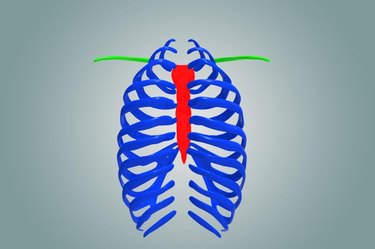
The collarbone connects the shoulder blades and the breast bone. Known to medical practitioners as the clavicle, it's the only long bone in the body that lies horizontally. Although numerous ligaments from the arm and shoulder attach to it, the collarbones themselves are unprotected by muscle. That's what makes it easy to locate, but it's also what makes it easy to injure. In fact, the collarbone is the most frequently broken bone in the body. With all those ligaments attached, and because it rotates when the shoulder moves, if something's put the hurt on one of them, you're going to feel it loud and clear — especially if you're doing push-ups.
However, your clavicle isn't necessarily broken. A painful collarbone during push-ups and other weight-bearing exercises may indicate a range of different problems from a mild case of tendinitis to injuries that should receive medical attention.
Video of the Day
Video of the Day
Read More: Shoulder Pain
Overtraining
Of course, you're dedicated to fitness, but are you overdoing it? One of the most common causes of athletic injury is overuse, which can traumatize muscles, tendons, ligaments and the rest of your innards, putting you on the path to pain. Tendinitis is inflammation of a tendon, while tenosynovitis is the same deal, but with inflammation of the tendon sheath lining. Both are most often associated with the shoulder and the tendon at the upper tip of the biceps, as well as the flexor carpi radialis. To treat tendinitis or other repetitive motion injuries, first stop doing anything that hurts. Apply heat for chronic inflammation or cold if it's an acute injury. Take over-the-counter anti-inflammatories such as aspirin, ibuprofen or naproxen. In severe cases, doctors may administer corticosteroid injections to relieve inflammation.

Fracture
Collarbone fractures typically occur when you fall on your shoulder or outstretched arm, or when you take a direct hit to the bone. In some cases, ligaments that attach the shoulder to the collarbone bone get torn, too, so now you've got a real case of the screaming meanies. Most collarbone fractures are treated by immobilizing the arm with a sling for four to six weeks. Severe fractures may require surgery, but if you've got a severe fracture, you probably won't be doing push-ups. Be that as it may, if you have reason to suspect you've fractured you're collarbone, you should definitely see a doctor. There's nothing quite like the deep, penetrating pain of a distressed bone to get you to a health care practitioner anyway.
Arthritis of the Shoulder
The shoulder has two joints and arthritis can affect each of them. One the acromioclavicular (AC) joint, where the collarbone meets the tip of the shoulder blade. There are five different kinds of arthritis, and the AC joint is susceptible to all of them, the most common being osteoarthritis. This erodes the smooth cartilage that reduces friction in the joints. Osteoarthritis in the shoulder usually affects people after age 50. Other kinds of arthritis can set in after a shoulder fracture or result from tears in the ligaments of the rotator cuff or disruption of the blood supply to the humerus.
Thoracic Outlet Syndrome
A number of major blood vessels and nerves are routed through a passageway between the neck and the chest called the thoracic outlet. Thanks to overcrowding, these vessels and nerves can get squeezed between various bones or muscles, resulting in pain, burning and tingling from the neck into the arms. Pressure, such as that exerted by push-ups, can jack up the pain and even cause swelling. In more severe cases, circulation is impaired. Thoracic outlet syndromes are most common in women between the ages of 35 and 55. For most folks, physical therapy and exercise can reduce or eliminate symptoms. Thoracic Outlet Syndrome does deserve medical attention.
Read More: Push-Ups & Arm Pit Pain